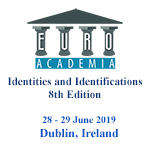Euroacademia Conferences
 Europe Inside-Out: Europe and Europeanness Exposed to Plural Observers (9th Edition) April 24 - 25, 2020
Europe Inside-Out: Europe and Europeanness Exposed to Plural Observers (9th Edition) April 24 - 25, 2020 Identities and Identifications: Politicized Uses of Collective Identities (9th Edition) June 12 - 13, 2020
Identities and Identifications: Politicized Uses of Collective Identities (9th Edition) June 12 - 13, 2020 8th Forum of Critical Studies: Asking Big Questions Again January 24 - 25, 2020
8th Forum of Critical Studies: Asking Big Questions Again January 24 - 25, 2020 Re-Inventing Eastern Europe (7th Edition) December 13 - 14, 2019
Re-Inventing Eastern Europe (7th Edition) December 13 - 14, 2019 The European Union and the Politicization of Europe (8th Edition) October 25 - 26, 2019
The European Union and the Politicization of Europe (8th Edition) October 25 - 26, 2019 Identities and Identifications: Politicized Uses of Collective Identities (8th Edition) June 28 - 29, 2019
Identities and Identifications: Politicized Uses of Collective Identities (8th Edition) June 28 - 29, 2019 The European Union and the Politicization of Europe (7th Edition) January 25 - 26, 2019
The European Union and the Politicization of Europe (7th Edition) January 25 - 26, 2019 7th Forum of Critical Studies: Asking Big Questions Again November 23 - 24, 2018
7th Forum of Critical Studies: Asking Big Questions Again November 23 - 24, 2018 Europe Inside-Out: Europe and Europeanness Exposed to Plural Observers (8th Edition) September 28 - 30, 2018
Europe Inside-Out: Europe and Europeanness Exposed to Plural Observers (8th Edition) September 28 - 30, 2018 Identities and Identifications: Politicized Uses of Collective Identities (7th Edition) June 14 - 15, 2018
Identities and Identifications: Politicized Uses of Collective Identities (7th Edition) June 14 - 15, 2018
Papers
Stop Signs and Cross-Roads: Barriers Faced by Multiethnic and First Generation Students in Higher Education
When multi-ethnic and/or first-generation students attempt to navigate campus spaces they are often met with academic and social barriers that prevent them from finding a sense of belonging on campus, which is integral in healthy identity development. By using an intersectionality approach to look at the intersection of multiethnic and first-generation identities, I argue that the barriers these students face are compounded, an instance not exclusive to these particular identities. I also argue that previous solutions in addressing these inequities are not sufficient and university administrators have a responsibility to recognize the role that they have in shaping identity spaces on campus for all students that facilitate healthy identity development.Between Deeds and Dreams: Identity as Phantasm (A Case Study in Diasporic Identities)
A static figure of the Jew was explicitly targeted as the paradigm of “difference.” Modigliani’s and Chagall’s contrasting bodies of work reflected their diverse formations in the worlds of Ashkenaz and Sepharad, thus revealing the fluidity of Jewish identity and imploding any temptation towards essentialism. Specifically, I show how Chagall’s Jew series (ca. 1911-15) destabilized fixed Jewish stereotypes via color and form. In contrast, Modigliani’s early, racialized portraits gave way to an eradication of race altogether in his later portraiture (c. 1916-19). This utopian gesture emerged from his Italian-Sephardic heritage. Both artists’ work approached prevailing visual culture from marginalized Jewish perspectives, and addressed salient issues facing an otherwise multifaceted people scattered throughout the world. Their imagery directly countered the ethno-centrism and anti-Semitism that, coursing through Post-Dreyfus France, would have widespread and devastating consequences on Jews and other fringe populations throughout Europe in the decades to come.Fluidity of Identity Built through Muscles: Between Sport and Artistic Creation
The main focus of this proposal lies in shattering the gender stereotype by means of the body modification carried out through bodybuilding, being critical of the suffocating regulations that these bodies have to meet when they are assessed on stage. We will focus on the context of art through female artists or transgender artists who have used this discipline to modify their bodies, and by doing so, have managed to give a stronger message than in the field of competition. Some of them will be Cassils (Canada-USA), Francesca Steele (UK), and the author of this proposal, Isa Fontbona (Spain).A Name in a Network: Constructions and Dissolutions of Identity in the Work of Philippe Thomas
The proposed talk will analyze Thomas’s project in the context of his socio-historical environment. Influenced by artists such as Richard Prince, Cindy Sherman, John Knight or Sherrie Levine, Thomas’s works often display the art world networks in which he aimed to inscribe himself. By looking at some of his activities in Paris and in New York, I will draft out misunderstandings and non-alignments between the French and American scenes, from readings of so-called French theory to queer activism. As I will argue, Thomas’s performance of non-identity is always aware of the impossibility to fully disappear as an author. The lecture analyzes this interplay and asks about the connections between Western art world centrisms, network imperatives and the queer play with artistic identity.Identity Politics in the Village of Ostrów: Manipulating Monolinguals to Augment Autochthonicity
A savvy campaign of cultural brokerage organized 300,000 autochthonous Opole Silesians in southwestern Poland into “the German Minority in Poland” within months of the 1989 transition. Leadership tapped deep feelings of belonging and alienation while also using community tri-lingualism to selectively present Silesian identity to monolingual speakers of German – journalists, politicians, donors. Over the course of one celebratory day in one village, identity was politicized onstage, in the audience, and in the woods where the day began with prayer and remembrance that turned into a revelatory argument.Loss of Loved Ones and Identification
Loss of loved ones and identification find expression in D.H. Lawrence's American writings in the form of replacement which becomes a routine habitual compensation for the loss of love-objects. Psychologically, human beings color aspects of their relation to the world outside them. Thus; they defamilliarize the affair to fill the void, replacing other(s) for the lost love-object. According to Freud, "the most obvious reaction is to identify oneself with it, to replace it from within, as it were, by identification." (Freud, 193)Locating the Self through Representing the Other: Occidentalism as a Strategy for Self-exclusion and Recognition in Mohja Kahf’s The Girl in the Tangerine Scarf
Taking Mohja Kahf’s novel The Girl in the Tangerine Scarf (2006) as a sample of Arab American literature, this paper tends to both examine and discuss the extent to which Arab American characters including Téta, Wajdy, and Khadra represent and identify white Americans from an Occidentalist point of view to exclude themselves from wider American society, and sustain their self-realization and recognition. The arguments and analysis in this paper are outlined within social identity theoretical framework based on Henry Tajfel and Homi Bhabha’s perspectives and Gayatri Spivaks’ postcolonial concept of the subaltern.Writing History is Making History, or How to Roll Back a Revolution or Two: Naked Among Wolves (1958; 1963; 2015) and the New Europe
The more charged a history, the higher the stakes. Reverberating the East like no other historical space, the history of Buchenwald needed to be rewritten for that bit of former Eastern bloc to fit into the ‘Heart of Europe’, or rather: into the ‘heart of a neoliberalist Europe.’ Yet, by the same token, rewriting the history of Buchenwald is also rewriting the legacy of the former East and, with it, the history of (the Other) Europe—a making of history that needs to be reflected as such.How are Iranian Gay Men Coping with Systematic Suppression Under Islamic Law? A Qualitative Study
The aim of this study is to use a qualitative approach to gain a more in-depth understanding of the coping strategies adopted by gay men living in Iran under systematic suppression based on each individual’s subjective experiences, feelings, intention, and beliefs. A semi-structured interview in Farsi (Persian) language was used to gather the qualitative data. Twenty-three men who identified themselves as gay and who currently live in Iran were interviewed for this study. Transcripts of the interviews were subjected to analysis using thematic analysis.Women’s Political Visualisation of Post-conflict Belfast
O’Dowd and Komarova (2013: 528) outline difficulties encountered when ‘theorising’ the city. Belfast, in Northern Ireland, they suggest, has been viewed as exemplar ‘conflict’ or ‘contested’ city, or one that it is ‘divided by deep-rooted ethno-national conflict.’ In late 2014, a group of women who live in the predominantly Protestant Tiger’s Bay and predominantly Catholic New Lodge ‘interface’ areas of North Belfast, worked cooperatively to produce a visual representation of their localities as a means of highlighting political issues affecting the post-conflict city. This visualisation took the form of a photobook containing images taken and edited by the women themselves.



